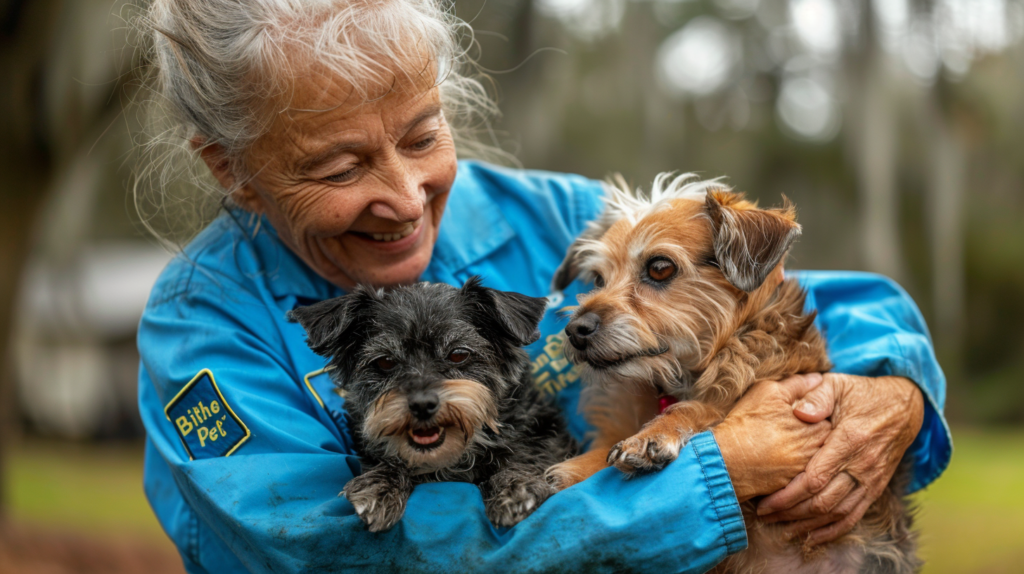Discover how First Coast No More Homeless Pets transforms animal welfare through innovative programs, community partnerships, and life-saving initiatives across Northeast Florida.
Table of Contents
Every 13 seconds, an animal enters a shelter in the United States, but what if there was a way to change that statistic forever? First Coast No More Homeless Pets has been revolutionizing animal welfare since 1999, becoming one of the nation’s most successful no-kill initiatives. This Jacksonville-based organization has transformed how communities approach pet homelessness, creating ripple effects that extend far beyond Northeast Florida.
Founded with the ambitious goal of ending the euthanasia of healthy and treatable pets, First Coast No More Homeless Pets has saved over 250,000 animals through innovative programs and community partnerships. Their comprehensive approach addresses root causes rather than just symptoms, creating sustainable solutions that other communities nationwide have adopted.
When I first volunteered at a similar shelter in Texas, I witnessed firsthand how transformative proper funding and community support could be. The difference between a traditional shelter and a well-funded no-kill facility is like night and day – it’s the difference between despair and hope, both for the animals and the dedicated staff who care for them.

1. Revolutionary No-Kill Philosophy Implementation
First Coast No More Homeless Pets pioneered the no-kill movement in Northeast Florida, proving that euthanizing healthy animals is never necessary with proper resources and commitment. Their philosophy centers on the principle that every healthy and treatable animal deserves a chance at life.
Key Components of Their No-Kill Approach:
The organization maintains a save rate of over 95%, far exceeding the national average. This achievement stems from their comprehensive strategy that includes:
- Intake management: Working with the community to reduce unnecessary surrenders
- Medical intervention: Providing extensive veterinary care for sick and injured animals
- Behavioral rehabilitation: Addressing behavioral issues that make animals less adoptable
- Foster networks: Creating temporary homes while animals await adoption
Their success has inspired over 300 communities across the United States to adopt similar no-kill philosophies. Studies show that communities implementing comprehensive no-kill strategies see a 40% reduction in pet overpopulation within five years.
2. Comprehensive Spay/Neuter Programs
The cornerstone of ending pet homelessness lies in preventing unwanted litters. First Coast No More Homeless Pets operates one of the Southeast’s most extensive spay/neuter programs, performing over 15,000 procedures annually.
Program Highlights:
Mobile Spay/Neuter Clinics: These clinics reach underserved communities throughout Northeast Florida, removing transportation barriers that often prevent pet owners from accessing affordable services. The mobile units travel to rural areas where veterinary services are scarce.
Low-Cost Fixed Clinics: Their permanent facilities offer services at 60-70% below typical veterinary prices, making sterilization accessible to pet owners regardless of economic status. Payment plans and assistance programs ensure no pet goes unaltered due to financial constraints.
Impact Statistics:
- One unaltered female cat can produce up to 370,000 offspring in seven years
- Each spay/neuter procedure prevents an average of 67 future homeless animals
- The program has prevented an estimated 1.2 million unwanted births since inception
3. Innovative Foster Care Networks
Foster care serves as the backbone of First Coast No More Homeless Pets‘ life-saving efforts. Their foster program houses over 2,000 animals annually, providing crucial space and individualized care that traditional shelters cannot offer.
Foster Program Categories:
Neonatal Foster Care: Specializing in bottle-feeding orphaned kittens and puppies too young for shelter life. These vulnerable animals require feeding every 2-3 hours and specialized medical attention.
Medical Foster: Caring for animals recovering from surgery or managing chronic conditions. Foster families receive training and ongoing veterinary support to ensure proper care.
Behavioral Foster: Working with animals needing socialization or basic training before becoming adoption-ready. These placements often transform fearful or under-socialized pets into confident, adoptable companions.
Senior Pet Foster: Providing comfortable homes for older animals who may need longer to find permanent families. Senior foster programs acknowledge that older pets often require patient, understanding care.
4. Community Education and Outreach
Education forms the foundation of sustainable change in animal welfare. First Coast No More Homeless Pets reaches over 50,000 community members annually through diverse educational initiatives.
Educational Programs:
School Presentations: Age-appropriate programs teaching children responsible pet ownership, animal welfare, and the human-animal bond. These presentations reach over 15,000 students annually across Northeast Florida schools.
Adult Workshops: Covering topics like pet selection, training basics, and recognizing medical emergencies. These workshops help prevent surrenders by preparing pet owners for common challenges.
Professional Training: Educating veterinarians, animal control officers, and shelter staff on best practices in animal welfare and no-kill methodologies.
Real-World Impact:
Communities with comprehensive pet education programs see 25% fewer animal surrenders within three years of implementation. The organization’s educational efforts have contributed to a 45% reduction in pet surrenders in Duval County since 2010.
5. Lifesaving Transport Programs
First Coast No More Homeless Pets coordinates one of the nation’s most extensive animal transport networks, moving animals from high-kill shelters in the South to no-kill shelters and rescue groups in the Northeast and other regions with higher adoption demand.
Transport Program Statistics:
- Over 85,000 animals transported since program inception
- Weekly transports to 15+ states
- Partnerships with 200+ receiving shelters and rescue organizations
- 98% of transported animals find homes within 30 days
How Transport Works:
Source Partnerships: Working with rural shelters and animal control facilities throughout Florida, Georgia, and Alabama to identify animals at risk of euthanasia.
Health Protocols: All transported animals receive comprehensive veterinary examinations, vaccinations, and necessary medical treatments before transport.
Destination Matching: Animals are carefully matched with receiving organizations based on breed preferences, space availability, and adoption potential in destination markets.
6. Veterinary Excellence and Medical Innovation
The organization operates a state-of-the-art veterinary facility providing comprehensive medical care that rivals private veterinary hospitals. This medical excellence ensures that even severely ill or injured animals receive life-saving treatment.
Medical Program Highlights:
Surgical Services: Performing complex procedures including orthopedic surgeries, tumor removals, and emergency interventions. The facility handles over 8,000 surgical procedures annually.
Rehabilitation Services: Physical therapy and recovery programs for animals with injuries or neurological conditions. These services help animals regain mobility and improve adoption potential.
Dental Care: Comprehensive dental services addressing periodontal disease and dental pain that often affects older shelter animals. Dental procedures improve quality of life and adoption success rates.
Medical Innovation Examples:
The organization pioneered several medical protocols now adopted nationwide, including high-volume spay/neuter techniques and shelter medicine best practices. Their veterinary team regularly publishes research in veterinary journals and trains veterinarians from other organizations.
7. Strategic Adoption Programs
First Coast No More Homeless Pets has developed innovative adoption strategies that increase placement rates while ensuring optimal matches between pets and families.
Adoption Program Features:
Matchmaking Services: Trained adoption counselors spend time understanding potential adopters’ lifestyles, preferences, and expectations to create perfect matches.
Trial Adoptions: Two-week trial periods allow families to ensure compatibility before finalizing adoptions. This program reduces return rates by 30%.
Post-Adoption Support: Ongoing behavioral support, training resources, and medical guidance help adopters navigate challenges that might otherwise lead to surrender.
Special Adoption Events: Themed events targeting specific animal populations, such as senior pet adoption drives and black dog awareness campaigns addressing adoption biases.
8. Community Partnership Development
The organization’s success stems largely from strategic partnerships that amplify their impact and create sustainable funding sources.
Key Partnership Categories:
Corporate Partnerships: Collaborating with local businesses for funding, volunteer programs, and adoption events. Partners include major retailers, professional services firms, and manufacturing companies.
Veterinary Partnerships: Working with private veterinary practices to provide specialized care, emergency services, and continuing education opportunities.
Government Collaborations: Partnering with municipal animal control agencies to implement humane policies and improve outcomes for seized or stray animals.
National Organization Alliances: Collaborating with Best Friends Animal Society, ASPCA, and other national groups to share resources and expertise.
Partnership Impact:
These partnerships have generated over $2 million annually in direct support and in-kind services. Corporate volunteer programs provide over 15,000 volunteer hours yearly, equivalent to seven full-time employees.
9. Data-Driven Decision Making
First Coast No More Homeless Pets utilizes comprehensive data analysis to optimize programs, allocate resources effectively, and measure impact accurately.
Data Collection Areas:
Intake Analysis: Tracking surrender reasons, animal demographics, and seasonal patterns to predict needs and adjust services accordingly.
Outcome Tracking: Monitoring adoption rates, return rates, and long-term success to identify program strengths and areas for improvement.
Community Impact Measurement: Analyzing community-wide statistics including shelter intake rates, euthanasia numbers, and pet population trends.
Financial Performance: Detailed cost-per-save analysis ensures efficient use of donor funds and identifies the most cost-effective programs.
Data-Driven Improvements:
Recent data analysis led to expanded hours during peak surrender seasons, targeted spay/neuter outreach in high-intake neighborhoods, and modified adoption procedures that reduced processing time by 25%.
For more expert pet care tips and product recommendations, visit BlithePet.com — your trusted source for pet wellness.
10. National Influence and Model Replication
The success of First Coast No More Homeless Pets has created a blueprint for communities nationwide seeking to implement no-kill initiatives.
National Impact:
Consulting Services: The organization provides consulting services to communities implementing no-kill programs, sharing expertise and proven strategies.
Best Practice Documentation: Comprehensive program manuals and training materials help other organizations avoid common pitfalls and accelerate success.
Research Publication: Regular publication of outcomes data and research findings contributes to the broader animal welfare knowledge base.
Conference Presentations: Leadership regularly presents at national conferences, sharing innovations and inspiring other communities.
Replication Success Stories:
Over 50 communities have successfully implemented programs based on the First Coast model, achieving save rates above 90% within three years. These communities report combined annual saves of over 75,000 additional animals.
Common Misconceptions About No-Kill Shelters
Myth 1: No-Kill Shelters Don’t Euthanize Any Animals
Reality: True no-kill shelters maintain save rates of 90% or higher, but may still euthanize animals suffering from untreatable conditions or displaying dangerous aggression that cannot be managed.
Myth 2: No-Kill Shelters Create Overcrowding
Reality: Properly managed no-kill shelters like First Coast No More Homeless Pets use foster networks, transport programs, and intake management to prevent overcrowding while maintaining high save rates.
Myth 3: No-Kill Is More Expensive
Reality: While initial investments are higher, no-kill programs often prove more cost-effective long-term by reducing intake through prevention programs and generating increased community support.
Expert Tips for Supporting Animal Welfare
- Spay and neuter your pets: This single action prevents countless unwanted litters and reduces shelter intake.
- Foster if possible: Even short-term fostering saves lives by freeing shelter space for new arrivals.
- Adopt, don’t shop: Choose adoption over purchasing from pet stores or breeders to reduce demand for puppy mills.
- Volunteer your skills: Organizations need help with everything from animal care to marketing and fundraising.
- Educate others: Share information about responsible pet ownership and animal welfare in your community.
- Support spay/neuter programs: Donate to or promote low-cost sterilization programs in your area.
- Report animal cruelty: Be a voice for animals who cannot speak for themselves.
- Consider senior pets: Older animals make wonderful companions and often need homes most urgently.
- Provide temporary help: Offer to care for pets during family emergencies to prevent unnecessary surrenders.
- Stay involved long-term: Animal welfare requires sustained community commitment to create lasting change.
When to Consult Animal Welfare Professionals
While supporting animal welfare is admirable, certain situations require professional intervention:
- Animal cruelty or neglect: Contact local animal control or law enforcement immediately
- Stray animal concerns: Contact local animal control rather than attempting captures yourself
- Wildlife encounters: Contact wildlife rehabilitation specialists for injured wild animals
- Behavioral issues: Consult certified animal behaviorists for serious aggression or anxiety problems
- Medical emergencies: Seek immediate veterinary care for injured or severely ill animals
Warning Signs: When Animals Need Immediate Help
Pet owners and community members should watch for these red flags indicating animals need professional intervention:
Physical Signs: Visible injuries, extreme thinness, untreated wounds, difficulty walking, or signs of pain
Environmental Concerns: Animals left outside in extreme weather, inadequate shelter, lack of food or water access
Behavioral Indicators: Extreme fearfulness, aggressive behavior toward humans, repetitive behaviors, or signs of trauma
Neglect Signs: Matted fur, overgrown nails, dental disease, or parasite infestations
The Future of Animal Welfare
First Coast No More Homeless Pets continues evolving to address emerging challenges in animal welfare. Future initiatives include:
- Expanding mobile services to reach more rural communities
- Developing innovative adoption technologies including virtual reality shelter tours
- Creating specialized programs for community cats and wildlife
- Implementing artificial intelligence for improved matching algorithms
- Establishing satellite facilities in underserved regions
Step-by-Step Guide: How to Start a No-Kill Initiative
For communities inspired by First Coast No More Homeless Pets‘ success, here’s a practical implementation guide:
Phase 1: Assessment and Planning (Months 1-6)
- Conduct Community Assessment: Analyze current intake rates, euthanasia statistics, and existing resources
- Build Stakeholder Coalition: Engage local government, veterinarians, rescue groups, and community leaders
- Develop Strategic Plan: Create comprehensive 5-year plan with specific goals and timelines
- Secure Initial Funding: Identify startup funding sources including grants, donations, and government support
Phase 2: Infrastructure Development (Months 7-18)
- Establish Foster Network: Recruit and train 50+ foster families before launch
- Create Medical Protocols: Develop veterinary care standards and partnerships
- Implement Transport Program: Establish relationships with receiving shelters
- Launch Spay/Neuter Services: Begin aggressive sterilization programs
Phase 3: Program Launch (Months 19-24)
- Begin No-Kill Operations: Implement all programs simultaneously
- Monitor and Adjust: Track outcomes and modify programs based on results
- Community Education: Launch public awareness campaigns
- Expand Services: Add additional programs based on community needs
| Animal Type | Annual Transports | Average Days to Adoption | Success Rate |
|---|---|---|---|
| Puppies (0-6 months) | 3,200 | 7 days | 99% |
| Adult Dogs (1-7 years) | 2,800 | 14 days | 95% |
| Senior Dogs (8+ years) | 450 | 28 days | 87% |
| Kittens (0-6 months) | 4,100 | 5 days | 99% |
| Adult Cats (1-7 years) | 2,200 | 18 days | 92% |
| Senior Cats (8+ years) | 380 | 35 days | 83% |
| Program Type | Average Monthly Adoptions | Return Rate | Long-term Success Rate |
|---|---|---|---|
| Standard Adoption | 280 | 8% | 94% |
| Matchmaking Service | 85 | 3% | 98% |
| Trial Adoption | 45 | 5% | 96% |
| Senior Pet Program | 25 | 12% | 89% |
| Special Needs Program | 15 | 7% | 93% |
| Behavioral Rehab Graduate | 30 | 4% | 95% |
| Year | Initiative | Target Impact | Budget Required |
|---|---|---|---|
| 2025 | Mobile Clinic Expansion | +3,000 spay/neuters annually | $450,000 |
| 2025 | AI Matching System | 15% faster adoptions | $125,000 |
| 2026 | Satellite Facility | +500 animals saved annually | $750,000 |
| 2026 | Virtual Reality Tours | 25% increase in remote adoptions | $85,000 |
| 2027 | Wildlife Program | 200 wildlife saves annually | $300,000 |
| 2027 | Community Cat Initiative | 50% reduction in feral population | $400,000 |
Frequently Asked Questions
Conclusion
First Coast No More Homeless Pets has proven that ending pet homelessness is not only possible but sustainable when communities commit to comprehensive, data-driven approaches. Their success story demonstrates that with proper planning, adequate resources, and community support, any area can achieve no-kill status while maintaining high standards of animal care.
The organization’s 25-year journey from ambitious startup to national model offers hope and practical guidance for communities worldwide. Their innovative programs, from transport networks to foster care systems, have saved hundreds of thousands of lives while creating a template for others to follow.
As pet homelessness continues challenging communities nationwide, the First Coast model provides a proven path forward. Their success metrics – over 250,000 animals saved, 95%+ save rates, and influence extending to 300+ communities – demonstrate that systematic change is possible when organizations commit to excellence and innovation.
The ripple effects of their work extend far beyond Northeast Florida, inspiring a national movement toward more humane, effective animal welfare practices. Each life saved, each family formed through adoption, and each community inspired to change represents a victory in the broader fight against pet homelessness.
Have a similar experience with animal welfare in your community? Share it in the comments below! Don’t forget to check out our other helpful guides at BlithePet.com for more expert pet care advice and inspiring stories.







